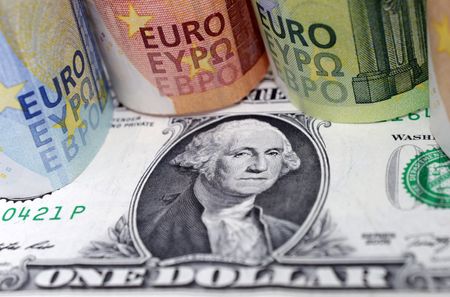By John McCrank
NEW YORK (Reuters) -The dollar rallied on Friday but was set for a weekly drop as traders weighed improving U.S. inflation data against comments from Federal Reserve officials who cautioned the battle against rising prices was far from over.
U.S. import prices declined for the first time in seven months in July on lower costs for both fuel and non-fuel products, data showed on Friday, in the third report this week to hint inflation may have topped out.
Another two key inflation measures, for consumer prices and producer prices, cooled in July, data on Wednesday and Thursday showed, prompting traders to pare back views that the Fed will raise interest rates by 75 basis points for a third consecutive time when it meets in September.
After four straight down days, including a more than 1% drop on Wednesday, the dollar rallied against its major rivals on Friday, but was still on track for a decline of around 0.84 for the week.
At 3:00 p.m. Eastern time (1900 GMT), the dollar index was up 0.504% at 105.65.
“There’s a little bit of anxiety still out there, I believe, because we need to see more evidence that inflation is – I’m not going to say abating – but peaking,” said Amo Sahota, director at Klarity FX.
The greenback’s turnaround followed a steady drumbeat from Fed officials who made clear they would continue to tighten. San Francisco Federal Reserve Bank President Mary Daly said on Thursday she was open to the possibility of another 75 basis point hike in September.
“The Fed is going to be inclined to push back against the notion of a premature policy pivot,” said Joe Manimbo, senior market analyst at Convera. “That would threaten to unravel all of the hard work they’ve done to bring down inflation.”
Traders were pricing in around a 42.5% chance of a 75 bps Fed rate hike in September and a 57.5% chance of 50 bps.
Kit Juckes, head of FX strategy at Societe Generale, said dollar trading was likely to remain “choppy”.
“It’s not going to be going significantly weaker in a straight line because there’s still a danger that the market has to reprice terminal Fed funds higher, given there’s still plenty of inflation,” Juckes said.
The dollar was up 0.39% against Japan’s currency, with the greenback at 133.495 yen.
The British pound fell 0.6% to $1.2141 versus the dollar. Data showed UK GDP contracted by less than forecast in June, even though an extra public holiday had been expected to cause a big drag.
The euro was down 0.53% at $1.02625. French inflation was up 6.8% year-on-year in July, while for Spain it was 10.8%, the highest since 1984, data showed.
The euro has been weighed down by Europe’s struggles with the war in Ukraine, the hunt for non-Russian energy sources and a hit to the German economy from scant rainfall.
Commerzbank said in a note it had revised its euro-dollar forecast lower, as it expects a euro-area recession as a base scenario, having previously been a “risk scenario”.
The bank said it expects the euro to fall to $0.98 in December and to not recover until later in 2023.
The New Zealand dollar was lifted by expectations of a Reserve Bank of New Zealand rate rise next week.
(Reporting by John McCrank in New York; additional reporting by Elizabeth Howcroft in London; Editing by Alexander Smith and Alex Richardson)





